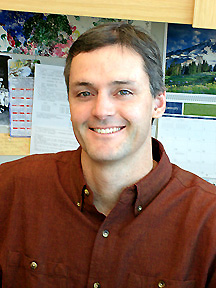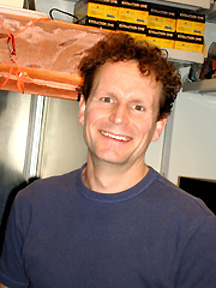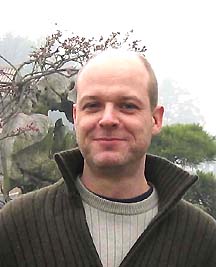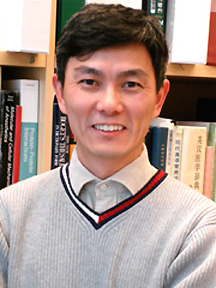
| T H E N I H C A T A L Y S T | J A N U A R Y – F E B R U A R Y 2008 |
|
|
|
| P E O P L E |
RECENTLY TENURED
 |
|
Mirit
Aladjem
|
Mirit Aladjem received her Ph.D. from Tel Aviv University in Israel in 1991 and performed her postdoctoral studies at the Salk Institute in La Jolla, Calif. She joined the Laboratory of Molecular Pharmacology, NCI, as head of the DNA replication group in October 1999. She is now a senior investigator in that lab.
My group studies the regulation of DNA replication in mammalian cells. We ask how cell-cycle signaling pathways regulate DNA replication and how replication coordinates with gene expression and chromatin condensation.
During the S-phase of the eukaryotic cell cycle, particular sections of the genome replicate at different times, yet it is striking that replication of the entire genome is coordinated such that each and every genomic locus replicates exactly once.
To achieve the high precision of DNA replication, cell-cycle regulators must interact with chromatin to ensure that replication starts at the correct location and the exact time. The cell-cycle machinery must also receive signals from replicating chromatin to detect and respond to replication errors.
We use a genetic approach to identify DNA sequences that determine where and when replication starts and then use those sequences to find proteins that bind them. Such proteins are likely to signal from the cell-cycle network to chromatin and back, facilitating proper cell-cycle progression and ensuring genomic integrity.
We have identified DNA sequences—termed "replicators"—that determine the location of replication initiation events. We have also identified DNA sequences that dictate the timing of DNA replication—these are termed "replication timers." Interestingly, some sequences can act as both replicators and replication timers, whereas others affect the timing but not the location of DNA replication.
We have dissected the sequence requirements for replicators and replication timers and shown that these genetic elements also affect epigenetic modifications on chromatin. Importantly, replicator sequences can prevent gene silencing, suggesting that replicators might be used to improve the expression of gene-therapy vectors.
Current studies aim to identify proteins that bind replicators and replication timers. Such proteins likely dictate the time and location of initiation of DNA replication and play a role in coordinating replication with other processes that occur concomitantly on chromatin, such as transcription.
We are also asking how cells respond to perturbation of DNA replication—an important question because the sensitivity of cells to anticancer drugs often depends on cell-cycle checkpoint pathways that are activated when DNA replication is perturbed. We tracked replication patterns on single DNA fibers to examine how cells recover from a mild drug-induced disruption of DNA replication.
We found that cells can convert perturbed replication forks into DNA breaks. The conversion process requires a nuclease (Mus81) and a helicase (Bloom’s syndrome helicase). The DNA breaks are transient; a recombination process (nonhomologous end-joining) repairs them and restores DNA replication.
Cells that cannot form transient DNA breaks, or cells that form breaks but cannot repair them, are very susceptible to drugs that inhibit DNA replication. These observations suggest that the pathway that forms and repairs transient DNA breaks is essential for cellular adaptation to varying rates of DNA replication.
As we continue to identify proteins that interact with chromatin, we need to create tools that will help scientists understand how those interactions integrate into a network that affects cell-cycle progression.
In collaboration with Kurt Kohn, Yves Pommier, and John Weinstein from the LMP, we organize current knowledge about cell-cycle regulation using the molecular interaction map (MIM) notation first proposed by Kohn. Our electronic MIMs are available at this website and allow easy navigation within pathways as well as links to pertinent additional data in the form of annotations and references. In collaboration with Jeff McFadden from NIST, we use MIMs to guide simulation-based studies of the control principles underlying bioregulatory networks.
 |
|
Jeffrey
Diamond
|
Jeffrey Diamond received his Ph.D. from the University of California, San Francisco, in 1994. He completed a postdoctoral fellowship at the Vollum Institute of the Oregon Health & Science University, Portland, before joining NINDS as an investigator in 1999. He is currently senior investigator in the Synaptic Physiology Unit, NINDS.
My lab explores how neurons communicate at synapses. At most synapses, the presynaptic cell releases a diffusible neurotransmitter that activates receptors on the postsynaptic cell. Our studies are designed to explore which features of synapses affect their strength, reliability, and, ultimately, their function within neural circuits.
We are studying how synaptic communication in the hippocampus depends on the diffusion dynamics of the neurotransmitter glutamate and how glutamate transporters regulate this process. Transporters in glial astrocyte membranes take up most synaptically released glutamate and maintain glutamate at low levels outside of cells, preventing glutamate-induced neurototoxicity.
The synaptic physiology field focuses primarily on glutamate’s actions within the synaptic cleft, but we also know that synaptically released glutamate can diffuse beyond the cleft to activate targets outside the synapse, a phenomenon referred to as "spillover."
We do not yet understand the effect of spillover on synaptic communication in the brain. The extent to which spillover occurs depends on how long glutamate is permitted to diffuse after its synaptic release. We measure this by recording electrophysiological signals associated with the transport process from glial cells in brain slices. In addition, we can record the time course of synaptic and extrasynaptic receptor activation tracking similar signals from neurons. We have found that glial transporters remove synaptically released glutamate very quickly—within a millisecond of release—but that receptors are still activated by spillover.
Specific roles for neuronal transporters are less clear, but we have shown that they protect NMDA receptors in the hippocampus from glutamate spillover, thereby aiding the learning and memory functions of these receptors. We also have shown that neuronal transporters contribute to inhibitory synaptic transmission by providing substrate for the synthesis of the inhibitory neurotransmitter GABA.
By limiting glutamate spillover and enhancing inhibition, neuronal transporters may constitute an endogenous safeguard against hyperexcitability leading to seizure activity in epilepsy—an idea we plan to test in the future.
Our work on the retina focuses on specialized synapses that shape the time course of the visual signal in the inner retina. Bipolar cells, which receive input from photoreceptors, convey graded "analog" synaptic signals to amacrine and ganglion cells.
Synaptic feedback inhibition from amacrine cells to bipolar cell synaptic terminals confers temporal precision required for more complex visual processing.
We are examining the synaptic and cellular mechanisms that regulate the feed-forward analog signals and the inhibitory feedback. We are also studying synaptic activation of ganglion cells, the neurons that form the output signal that is transmitted from the retina through the optic nerve to the rest of the brain.
We are particularly interested in the role of NMDA receptors in ganglion cell activation and have shown that NMDA receptors on some ganglion cells are excluded from the synaptic cleft and activated only during stronger synaptic stimulation. This exclusion may serve to extend the range over which ganglion cells can encode changes in light-stimulus intensity.
In addition, we think that calcium that enters the cell through NMDA receptor channels may contribute differently during different components of the visual signal, and we are designing experiments to elucidate this process. Overall, we aim to understand how synapses are optimized to perform specific tasks required by the surrounding neural circuitry.
 |
|
John
Isaac
|
John Isaac received his Ph.D. from the University of Southampton in the United Kingdom in 1994. He completed his postdoctoral training at the University of California, San Francisco, before returning to the United Kingdom to start an independent laboratory at the University of Bristol in 1997. He returned to the United States in 2004 to join NINDS as a tenure track investigator. He is currently senior investigator and chief of the Developmental Synaptic Plasticity Section, NINDS.
During early postnatal development, neuronal circuits in the mammalian brain self-organize into functional networks able to efficiently process information and produce appropriate output. Dysfunction of this critical process is thought to contribute to several neurological disorders including autism and schizophrenia.
Our laboratory investigates the molecular and cellular mechanisms underlying development of neuronal circuits. The primary focus is to understand how long-lasting changes in the strength of synaptic connections between neurons produce functional circuitry.
We use electrophysiology in brain slices combined with live imaging and molecular manipulations to study the mechanisms regulating synaptic function during development.
Using the somatosensory system of the rodent we investigate the mechanisms by which sensory experience causes long-lasting changes in synaptic strength of excitatory and inhibitory networks in layer 4 of neocortex. Layer 4 is the input layer of primary sensory neocortex, receiving the majority of ascending sensory input from the periphery.
Our somatosensory cortex studies have revealed a critical developmental window when the balance of inhibitory-excitatory drive in the layer 4 circuit is established. In the mouse, feed-forward inhibitory circuitry—which is driven by ascending sensory input from the thalamus—is dormant in the first postnatal week but is rapidly recruited during a two- to three-day period at the start of the second postnatal week.
This surprisingly rapid development of the inhibitory network suggests that sensory experience may play a role in shaping the inhibitory network at a very precise developmental time. We are now investigating the mechanisms driving the recruitment of feed-forward inhibition.
In work on mechanisms of synaptic plasticity at hippocampal CA1 synapses, we have found that PICK1, a protein that directly interacts with AMPA-type glutamate receptors, is an essential part of the expression mechanism for long-term potentiation (LTP) and long-term depression. Moreover, we find that PICK1 rapidly regulates the calcium permeability of AMPA receptors during LTP. This intriguing novel mechanism provides a potential therapeutic target to prevent excitotoxicity mediated by calcium-permeable AMPA receptors that occurs during cerebral ischemia.
We are also developing novel approaches to analyze circuit function in brain slices. We have devised a method to use two-photon laser uncaging of glutamate to activate individual neurons in layer 4 of somatosensory cortex. This enables us to probe the connectivity and synaptic properties of the layer 4 circuit with high spatial and temporal precision.
In addition, we are using virally transfected channel rhodopsin 2, a light-activated ion channel, to selectively activate specific inputs using light. We have succeeded in labeling thalamic inputs to neocortex and are using this technology, combined with calcium imaging, to map thalamic-recipient spines in layer 5 pyramidal neurons.
Such optical technologies combined with electrophysiology are now enabling us to analyze neocortical circuits and will facilitate high-resolution probing of developmental and experience-dependent changes in circuit function.
 |
|
Michael
Otto
|
Michael Otto received a Ph.D. degree in microbiology from the University of Tübingen, Germany, in 1998. He joined the Laboratory of Human Bacterial Pathogenesis at NIAID’s Rocky Mountain Laboratories in Hamilton, Mont., in 2001. He is now a senior investigator in that lab and head of the Pathogen Molecular Genetics Section.
Originally a biochemist with continuing education in microbiology, I am especially interested in the pathogenesis of staphylococcal infections. During my graduate and postdoctoral time at the University of Tübingen, under the supervision of Friedrich Götz, I studied Staphylococcus epidermidis, the most common cause of nosocomial infections.
My initial studies focused on a bacteriocin produced by S. epidermidis, and I later became interested in the pathogenetic mechanisms of this bacterium, most notably the process of biofilm formation.
Joining the Laboratory of Human Bacterial Pathogenesis expanded my opportunities for first-rate scientific interchanges. Work with neutrophil immunologist Frank DeLeo, especially, involving analysis of host-pathogen interactions led to enhanced understanding of the mechanisms underlying the success of S. epidermidis in nosocomial infections. More recently, in response to the epidemic outbreaks of methicillin-resistant Staphylococcus aureus (MRSA), my laboratory has started studying S. aureus, the more virulent cousin of S. epidermidis.
We have identified several novel mechanisms by which S. epidermidis evades human innate host defense. Most notably, we have conducted a detailed investigation of the structural factors and gene regulatory processes involved in biofilm development.
Interestingly, we found that a polysaccharide secreted by staphylococci as a biofilm matrix component plays a crucial role in immune evasion. We also discovered that S. epidermidis makes use of the same substance as Bacillus anthracis–poly-g-glutamic acid–to evade neutrophil phagocytosis and antimicrobial peptides. Further, global analysis of gene expression in biofilms yielded important insights into the physiological basis of biofilm resistance to antimicrobials and innate host defense.
Often, my research has revolved around bioactive peptides. In analyzing the mechanism of quorum sensing, or cell density–dependent gene expression, in staphylococci, we found that staphylococci signal cell density by means of a post-translationally modified peptide containing a thiolactone structure.
Much of my current research is focused on phenol-soluble modulins (PSMs), pro-inflammatory and leukocidal peptides that contribute to the exceptional virulence of community-associated MRSA. In addition, we believe that a different subclass of the PSMs contributes to structuring processes in a biofilm, and we continue investigating this putative double role of the PSMs in staphylococcal pathogenesis.
Finally, we recently identified the system that staphylococci (and likely many other Gram-positive bacteria) use to sense the presence of human antimicrobial peptides and trigger the expression of counteractive measures against this key part of innate host defense on the human skin.
While we have continued interest in S. epidermidis and biofilm development, we will concentrate on investigating the PSMs.
Much needs to be learned about these key virulence factors of S. aureus in terms of specific receptor interactions, structure-function relationships, and evolution. We hope these studies will contribute to the identification of targets for antistaphylococcal drug and vaccine development.
 |
| Ling-Gang
Wu |
Ling-Gang Wu received his Ph.D. in neuroscience in 1994 from Baylor College of Medicine in Houston, Texas. He did postdoctoral work at the University of Colorado, Denver, and the Max-Planck Institute for Medical Research, Heidelberg, Germany, from 1994 to 1999. He was an assistant professor at Washington University in St. Louis in 1999 before joining NINDS as an investigator in 2003. He is currently a senior investigator in the Synaptic Transmission Unit, NINDS.
Neurons communicate with each other mostly via synaptic transmission. Regulation of the strength of synaptic transmission plays essential roles in many physiological and pathological processes, such as control of neuronal network outputs, neuronal development, learning and memory, and neurological diseases.
Consequently, it is essential to understand how synaptic strength is determined, maintained, and regulated.
During the past eight years, we have studied endocytosis, which is essential to the maintenance of synaptic strength because it retrieves and thus recycles vesicles at the nerve terminal.
How endocytosis is mediated and regulated is poorly understood. We developed a system that enables measurement of both rapid and slow endocytosis, applying a high time-resolution technique—called capacitance-measurement technique—to a large central synapse, the calyx of Held in the auditory brainstem.
At this central synapse, we provided a systematic view of the time course of endocytosis in various stimulation conditions. We found that rapid endocytosis is activated by calcium during strong nerve activity, which may speed up the vesicle recycling needed to maintain synaptic transmission during intensive nerve activity.
We have identified three modes of endocytosis that may give rise to different time courses: a rapid kiss-and-run mode that allows for rapid-fusion pore opening and closure; a slow mode; and a rapid bulk endocytosis, which retrieves a piece of membrane much larger than a single vesicle. These findings contribute to a current debate and challenge a generally accepted view.
We provided the most direct evidence to date to support the existence of the kiss-and-run form at synapses, about which there has been much debate. Regarding bulk endocytosis, we countered the generally held opinion that this is a very slow form, with a time course of minutes.
Using the capacitance-measurement technique, which provides a high time resolution, we showed that bulk endocytosis may take only a few seconds after stimulation. Thus, bulk endocytosis may also provide a mechanism to speed up endocytosis.
In summary, we have shown how different modes of endocytosis participate to retrieve fused vesicles. Regulation of these different modes may therefore provide a mechanism to generate synaptic plasticity during various patterns of nerve activity.
In addition to the research on fusion and retrieval, we also studied short-term synaptic plasticity, which is involved in controlling the output of the synapse and the neuronal circuit. In particular, we worked on short-term depression (STD) of synaptic transmission that can be caused by repetitive firing at many synapses.
We found that a calcium-calmodulin–mediated inactivation of calcium channels in the nerve terminal contributes significantly to the generation of STD—a finding that overthrows the long-held view that STD is mainly caused by depletion of a readily releasable pool of vesicles.
Our findings contribute to our understanding of how synaptic strength and the output of neuronal circuits are controlled and regulated.